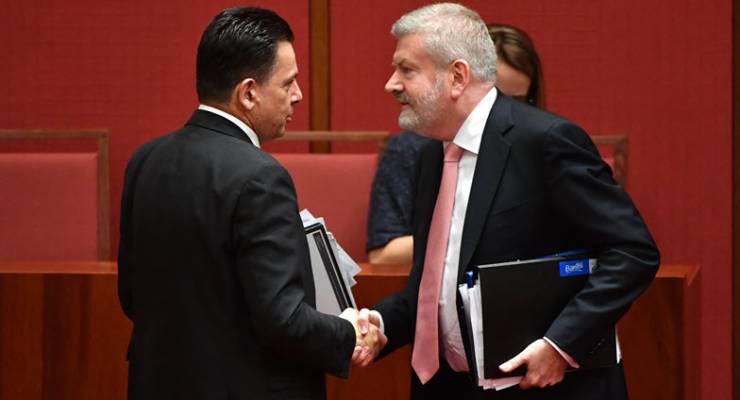
Australian media policy seems to have slipped into that grey, twilight world of half-hearted industry policy of grants and rebates from which few industries ever return.
“Policy” might be a strong word. More like $30 million here, $60 million there … none of it with a clear plan to multiply activity and none of it even close to the millions in content cost-cutting already foreshadowed by the major media corporations.
As we’d expect from Australian government policy, the largest slab of welfare to media corporations was the “regulatory relief” from the television and licence fees that went to the existing licence holders attempting to make profit off the publicly owned spectrum.
According to the Australian Communications and Media Authority, this was worth $127 million last financial year alone, or about six times the annual value of the Xenophon-initiated small and regional media fund.
Next came the undocumented $30 million over four years to Foxtel to broadcast “women’s sports, niche sports, and sports with a high level of community involvement and participation”. That was announced as part of the May budget, and Communications Mitch Fifield told the ABC’s Insiders this past weekend that we would find out what this meant once Foxtel told the government what it would do for the money.
[Are Xenophon’s media reform measures worth a hill of beans?]
Then, last week, came the $60.4 million fund over three years agreed to with Senator Nick Xenophon in exchange for his support of the government’s media changes, which already included making permanent the licence fee waiver.
According to Xenophon’s website, this will be dedicated to civic journalism: “investigating and explaining public policy and issues of public interest or significance with the aim of engaging citizens in public debate and informing democratic decision making”.
Much of the money will replicate existing government programs of tax deductions to buy equipment and rebates for research and development to develop digital products, although it’s a sign of how quickly this space is moving that the reference to “apps” already feels out of date.
The fund excludes salary costs — the major component of content creation, particularly journalism.
On the positive side, the fund can be used for the major challenge facing journalism: growth, innovation and “initiatives that explore and expand the journalism funding model”. It also appears to be agnostic between commercial and not-for-profit entities.
With those caveats we’re left with about $16.7 million a year for Australian-controlled small publishers that are members of the Australian Press Council (or have a robust complaints mechanism), capped at $1 million a year to each company. Currently, this applies to just four organisations: Private Media (owner of Crikey), Mumbrella, New Matilda and Schwartz Media (publisher of The Monthly magazine and The Saturday Paper).
Like so many half-decent policy ideas in Australia, the development fund was quickly hijacked by the political imperative of appeasing rural and regional Australia, as if reporting the words of random shire councillors is a greater need than telling stories to the city communities where most Australians actually live.
[Media reform: how the sausage got made]
In this case, two-thirds of the fund (about $11 million a year) is preserved for regional media. The problem with this restriction is that it’s difficult to see which existing companies will benefit. Almost all regional publishers are owned by Fairfax Media, followed by News Corp and Seven West Media. Television stations are part of networks, as is a lot of radio. So most of the potential beneficiaries are too large and/or too foreign to qualify.
The requirement for Press Council membership will restrict this amount to that almost Trump-sized-hand-full of independent regional publishers that are members of Country Press Australia — maybe another half a dozen publishers.
The deal also dedicates $8 million in matching payments for cadetships and scholarships, again with a significant regional bias.
The money will be granted under an arm’s-length process through ACMA. The Guardian, among others, has expressed concern that that the fund is structured to exclude voices the government doesn’t like (including The Guardian and The New Daily). While there is an argument for excluding The Guardian from a small publishers program, based on its global turnover, the exclusion of The New Daily seems to reflect government animus to industry super more than good policy.
This exclusion by design reflects the concerns about any government-funded program of journalism.
The Xenophon statement is unequivocal that Fairfax and News are excluded from the program, although it may be that regional component parts of Fairfax Media and Seven West will end up being treated as separate publishers for the purposes of the program. It’s hard to see News Corp (excluded as foreign) being happy with that.
But then, given News Corp’s principled opposition to government funding of media, surely they wouldn’t want the money anyway!








In many OECD European countries, when a Govt grants concessions to industry, they also place an obligation on that industry. Some people call this the nature of business. In dear ‘ol Oz, we just love giving money away to companies. Ask for something back for the Oz taxpayer???? Don’t be silly, that sounds like socialism or something.
Local Content????? Australian produced TV or film? ……TV networks? ……No? ummmm, anyone? Sigh.
The subs to Foxtel from those addicted to women’s sport, in combination with the $30mill kiss, the Murdochry will not suffer, just their journos! What is it about journalism that the megas and the people don’t get? Our freedom depends on good journos doing a good job.